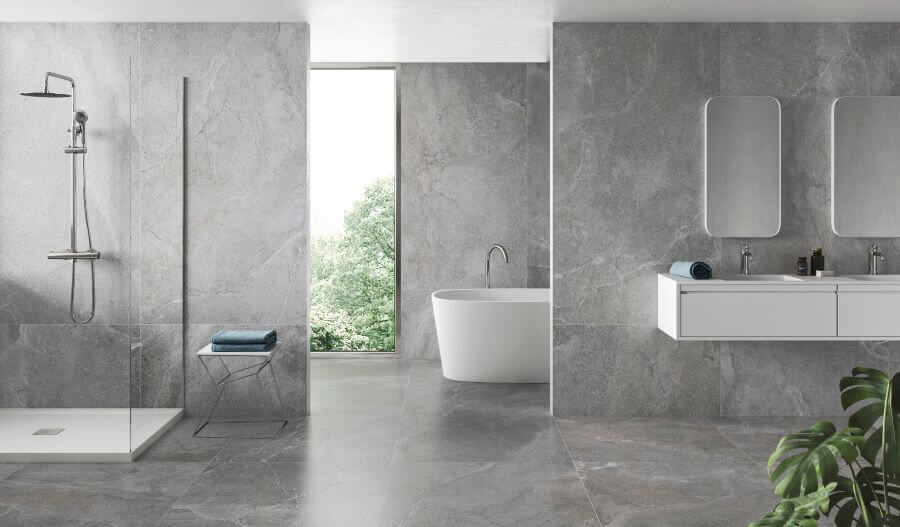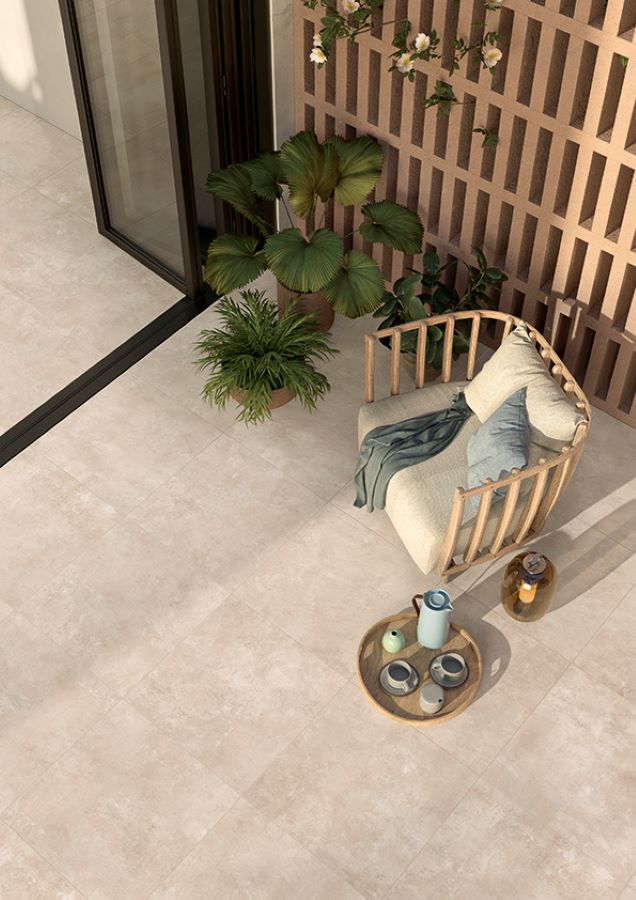
Bathrooms are generally the smallest rooms in the home. They can have difficult angles and from a design perspective there are all sorts of decisions to make. Just picking designer bathroom tiles includes a heap of decisions from tile colour, design, size, shape, porcelain or ceramic and tile finish.
Add to that decisions on exactly where you tile - floor and all walls, go half-height on the walls, tile just in the shower or behind the vanity and wow - all easy if you have some expert interior design help. Otherwise it can be a bit of a daunting task.
That's quite a broad question, but it is a good starting point. Our porcelain designer bathroom tiles are categorised by effect so it can be helpful to think about that as a starting point.
Marble - This noble material is in a league of it's own. From the imposing black veining of a Statuario to the drama of Marquina and a whole host of marbles in between, it is timeless.
Stone - Or perhaps you like the thought of a stone effect porcelain. Subtle background colours, light veining and in matt finishes or Satin.
Cements and concretes are perfect for creating a contemporary bathroom space. We've everything from whites with the merest whispers of grey fleck to stunning silver greys, dramatic charcoals and anthracites.
Metal effects and darker concretes are ideal for that industrial feel or for creating dark, moody spaces. There are some great white and silver metal effect tiles that can work on their own or in combination with other tiles and some wonderful colours in the form of greens and rusts.
Wood - with imitation of the real thing there are nowhere near the same limitations. The humidity of bathrooms is no issue for wood effect procelain. In the right slip rating, they can be used outside. Inside they are compatible with underfloor heating.
Whatever you choose, all our collections have designer bathroom tiles that range from cool to warmer tones and light to darker shades.
Tile finish will also impact how cool or warm the bathroom feels. Shiny, glossy tiles reflect more light so make spaces feel cooler. Matt finishes absorb more light so can make spaces feel warmer so even a cool white tile can feel softer and warmer with a soft matt finish.
There are so many options here and a mix of practicality and budget may dictate to a certain extent.
Tiling floor and all the walls is at one end of the spectrum. Tiles are super practical and there is little ongoing maintenance so once tiled, it does mean the job is done.
And with tile formats increasing, grout is less of an issue - as there is just less of it! Opting for rectified porcelain tiles (all our porcelain is rectified) means tiles have straight edges so grout lines for walls can be as little as 2mm. Many of our porcelains are in large formats as are our ceramic wall tiles.
At the other end of the scale is just tiling where you absolutely need to - around baths, showers, sinks.
In between both of those options are everything from tiling a couple of walls or tiling half height.
Technology has enabled a steady increase in tile sizes with larger formats becoming the 'go-to' especially for those seeking 'more tile, less grout'. Collections that comprised a few smaller tile sizes, now house 1200 x 600mm, 900 x 900mm and even larger sizes. There is no doubt about it, larger formats equal less grout - which is great thing for bathrooms. And they look stunning.
Grout lines can make a space feel really busy and boxed in as they bring a grid like appearance whereas larger formats can open up space.
Whatever tile you choose, it is important to speak with a professional installer, especially if you are looking to go for larger formats - it's critical floors and walls are prepared correctly and have been assessed for the suitability for your chosen tiles.
Porcelain is exceptionally hardwearing, scratch and stain resistant. Tiles are made from a mixture of finer clays and fired at a much higher temperature than ceramic tiles. All that makes for a heavier, denser material that is brilliant for walls and floors.
Ceramic tiles are less dense and lighter in weight than porcelain, that makes them easier to cut and so faster to install. They can be a great option for bathroom walls in particular. Bathrooms are generally smaller spaces than other rooms and can have awkward angles. Ceramics for walls also have some lovely creative textures and patterns making them excellent for creating a focal point in a room.
So here's a few ideas that bring together all of the above. For more ideas, go to our inspiration hub or call us and we can chat through your project and come up with some ideas for you!
We love this. The floor and back wall use our Season Caramel wood effect porcelain. These wood effect planks are large format 1510 x 240mm and are in our Contour finish - not only are there 36 different individual plank designs, the surface texture and wood pattern align for an ultra-realistic finish.
Mixing porcelain and ceramic can be a really clever way to make the most of your budget. Porcelain tends to be more expensive than ceramic and as it is denser it can be trickier to cut. So using ceramics for walls, especially in smaller bathrooms means they are easier to cut and quicker to install.
The real thing can be expensive and tricky to work with. Marble is also beautifully soft so it does need looking after as it is prone to scratching and sealing is a pre-requisite. Fortunately there are some exquisite porcelain effect tiles that are super hardwearing and are so good at mimicking the real thing, you may find it hard to tell the difference.
Most of our marbles are in both polished and matt finishes. When we think of marble we generally think Polished, however Natural finishes can completely transform a tile and are a great way of using marble in a contemporary setting. Marble works beautifully with woods and cements if you want to mix it up a little.
If you love the thought of darker designer bathroom tiles but you're concerned they may be too much then try pairing up with lighter whites or creams.
Cements and concretes make a brilliant canvas for bathrooms and leave furnishings and accessories to do the talking. They also marry beautifully with everything from woods to metals, quartz and more.
One of our favourites is our Docklands collection. The floor tiles are porcelain and can be complimented by the ceramic wall tiles.
This is the lightest of our 3 Haven tile colours. It's Stone and it really is a beautiful tile.
The background colour is a beautifully subtle warm taupe-grey and the veining is lovely and soft. It's a super versatile tile - could work pretty much anywhere and for bathrooms it makes a stunning canvas.
If you are in need of more inspiration go to our Inspiration hub where you will find more great bathroom ideas! Or need some advice on choosing designer bathroom tiles? We would be delighted to help so get in touch. We'd love to be your partner in design!
The TilePortfolio specialise in Italian and Spanish Porcelain and Ceramic tiles, in particular large format Porcelains and Porcelain tiles for inside and outside. Our carefully curated, stunning tile portfolios are beautifully presented online and supported by our fuss-free ‘go-the -extra-tile’ service and video design consultancy. Visit our website for unmissable interiors inspiration. The TilePortfolio team are always available to chat, we’d be delighted to help with your project so please do get in touch. www.thetileportfolio.co.uk.
Please note: We strongly recommend using a professional tiler for your project. Always check with your tiler regards suitability of your chosen tiles for your project.
GET IN TOUCH
Call, Text, WhatsApp: 07395 011861
Landline: 01536 856 108
Email: hello@thetileportfolio.co.uk
Visit Us: The TilePortfolio Showroom, Glebe Farm,
A14, Junction 7, Kettering, NN16 8XF
Company No. 13033923
VAT No. 376573947
Reg. Office: Headlands House 1 Kings Court
Kettering, Northants, NN15 6WJ
2024 © Copyright The TilePortfolio Limited
